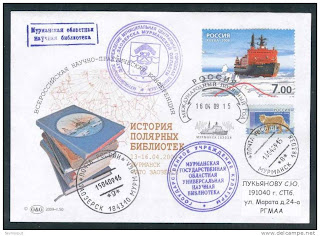
RUSSIAN POSTAL STATIONERY ENVELOPE - PINGUINS, POLAR BEAR, SAILING SHIP.
The XXX Scientific Committee on Antarctic Research (SCAR) Meeting and the SCAR and International Arctic Science Committee (IASC) Open Science Conference “Polar Research – Arctic
and Antarctic perspectives in the International Polar Year” were held in St. Petersburg, Russia between July 4th and July 11th 2008.
SCAR is the international committee responsible for initiation, promotion and co-ordination of high quality scientific research in Antarctica. SCAR is the leading international body for coordinating and facilitating scientific research in Antarctica and the surrounding Southern Ocean. The 34 national Members of SCAR are the national academies of science of the various countries. The SCAR science is designed by the academic and government scientists appointed by the national academies to address fundamental questions regarding what is to be found or seen in the Antarctic, how what is found or seen is controlled by underlying processes, and how that knowledge and understanding can be fed into advanced numerical models to forecast what change we may expect to see in the future.
The scientific business of SCAR is conducted by its three discipline-based Standing Scientific Groups (Geosciences, Life Sciences and Physical Sciences), which represent the scientific disciplines active in Antarctic research.
 MURMANSK and ZAOZERSK (MURMANSK REGION). ZAOZERSK POST OFFICE DATE 15.04.2009, MURMANSK TRANSIT POSTMARK DATE 16.04.2009.
MURMANSK and ZAOZERSK (MURMANSK REGION). ZAOZERSK POST OFFICE DATE 15.04.2009, MURMANSK TRANSIT POSTMARK DATE 16.04.2009.
